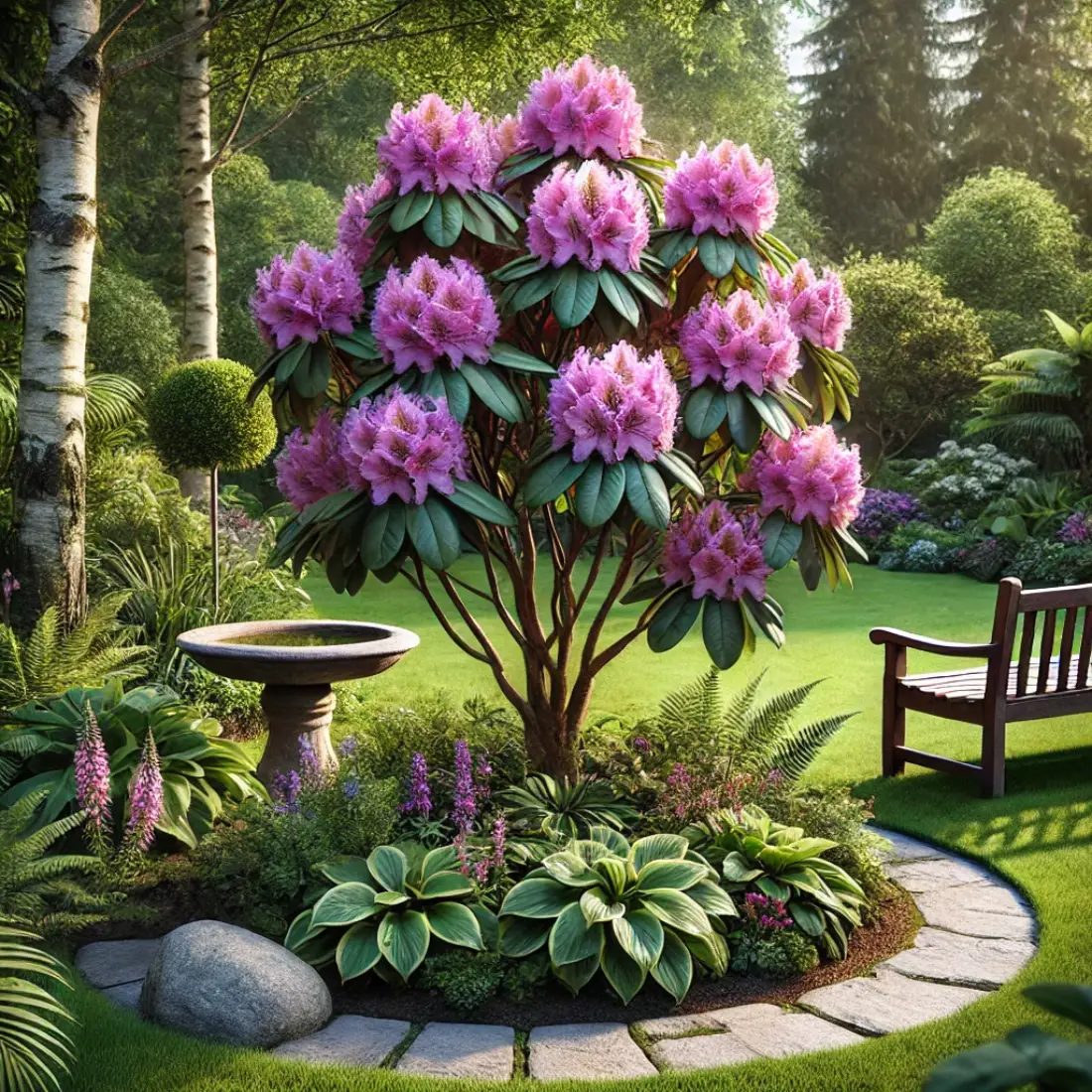Growing rhododendrons from cuttings is a rewarding way to propagate these stunning flowering shrubs. Unlike seeds, cuttings ensure that new plants are identical to the parent, preserving their beautiful characteristics.
This method is cost-effective and allows gardeners to expand their collection without purchasing new plants. While it requires patience and care, the process is straightforward with the right techniques.
- Propagating rhododendrons from cuttings ensures that new plants are identical to the parent, preserving their unique traits.
- The best time to take cuttings is in late spring to early summer, when the plant is actively growing.
- Proper preparation and care of the cuttings are crucial for successful rooting, including the use of rooting hormone and maintaining high humidity.
- Rooting can take 6-8 weeks; patience is essential during this period.
- Once rooted, the young rhododendrons need gradual acclimation to outdoor conditions and ongoing care to thrive.
Preparing for Cutting Propagation
Growing rhododendrons from cuttings starts with gathering the right tools and materials. You’ll need sharp pruning shears, a rooting hormone, a well-draining planting medium, small pots, and plastic bags to create a humid environment. These are essential for ensuring your cuttings have the best chance to root successfully.
Selecting the right cutting is crucial. Look for healthy, disease-free branches from a mature rhododendron plant. The ideal cutting should be about 4-6 inches long, taken from semi-hardwood growth, which is neither too young nor too old.
It’s best to take cuttings in late spring to early summer when the plant is actively growing. Make sure the cutting has a few leaves and at least one or two nodes, as these are where new roots will develop.
Preparing the cuttings involves a few careful steps. Start by removing the leaves from the lower half of the cutting, leaving only a few at the top. This reduces water loss and encourages the cutting to focus its energy on root development.
Make a clean cut just below a node using the pruning shears. Dip the cut end of the stem into the rooting hormone, which stimulates root growth and increases the chances of successful propagation.
Planting the prepared cuttings is the next step. Insert the cut end into the moist planting medium, ensuring that at least one node is buried. Firm the soil around the cutting to eliminate air pockets.
Cover the pot with a plastic bag or place it in a propagator to maintain high humidity, which is essential for rooting.
Rooting Rhododendron Cuttings
To successfully root rhododendron cuttings, choosing the right rooting medium is essential. A mix of peat moss and perlite is ideal, providing both moisture retention and good drainage. This environment is crucial for preventing rot while encouraging root development.
Once your cuttings are prepared, plant them in the moist rooting medium. Insert the cuttings so that at least one node is buried, with the leaves above the soil. Space the cuttings a few inches apart if you’re using a tray, or plant one per pot to avoid overcrowding.
To create the necessary high-humidity environment, cover the pot with a plastic bag or place it in a propagator. This mini greenhouse effect will keep moisture in, which is critical for rooting. Keep the cuttings in a warm, bright location, but out of direct sunlight, which can cause overheating and stress the cuttings.
Maintaining optimal conditions is key. Aim for a temperature of around 70-75°F (21-24°C) and keep the medium consistently moist but not waterlogged. Over the next 6-8 weeks, monitor the cuttings for signs of rooting, such as new growth. Be patient; successful rooting can take time.
Caring for Rooted Rhododendron Cuttings
Once your rhododendron cuttings have rooted, it’s important to transition them gradually to ensure their continued growth and health. Begin by transplanting the cuttings into larger pots filled with a well-draining, acidic soil mix suitable for rhododendrons. This gives the young plants more space to grow and access to nutrients.
Start acclimating the cuttings to outdoor conditions by gradually increasing their exposure to sunlight. Begin with a few hours of morning sun, slowly extending the time over several weeks. This process, known as hardening off, helps the plants adjust to the harsher outdoor environment, reducing the risk of transplant shock.
Watering is crucial during this stage. Keep the soil consistently moist but not waterlogged, as young rhododendrons are particularly sensitive to overwatering. A balanced, organic fertilizer can be applied sparingly to support growth, but be cautious not to over-fertilize, which can burn the delicate roots.
Troubleshooting Common Problems
When growing rhododendrons from cuttings, several issues can arise that may hinder successful rooting. One common problem is failure to root, which can be caused by using unhealthy or overly mature cuttings. Ensure you select semi-hardwood cuttings from healthy plants during the optimal season (late spring to early summer) for the best results.
Root rot is another frequent issue, often due to overwatering or using poorly draining soil. To prevent this, use a well-draining mix like peat moss and perlite and water the cuttings just enough to keep the soil moist, not soggy.
If you notice mold or fungus developing on the cuttings, it’s likely due to excess humidity or poor air circulation. Ensure that your propagation area has good airflow, and avoid over-sealing the humidity dome or plastic bag.
Wilting or yellowing leaves can indicate that the cuttings are under stress, possibly from too much direct sunlight, insufficient humidity, or nutrient deficiencies. Adjust the light exposure, mist the cuttings to maintain humidity, and ensure they are in a nutrient-rich medium.
FAQs about Growing Rhododendron from Cuttings
When is the best time to take rhododendron cuttings?
The ideal time to take rhododendron cuttings is in late spring to early summer when the plant is actively growing and the wood is semi-hard.
How long does it take for rhododendron cuttings to root?
Rhododendron cuttings typically take about 6-8 weeks to root, though some varieties may take longer depending on the conditions.
What type of soil is best for rooting rhododendron cuttings?
A mix of peat moss and perlite is ideal for rooting rhododendron cuttings, as it provides good drainage while retaining enough moisture.
Should I use rooting hormone on rhododendron cuttings?
Yes, using a rooting hormone can significantly improve the chances of successful rooting by stimulating root growth.
How often should I water rhododendron cuttings?
Water the cuttings just enough to keep the soil moist but not waterlogged. Overwatering can lead to root rot.
Can rhododendron cuttings be rooted in water?
Rhododendron cuttings are best rooted in a soil mix rather than water, as they require a stable, well-draining environment to develop strong roots.
What should I do if my cuttings develop mold?
If mold appears, improve air circulation around the cuttings and reduce humidity. Also, check to ensure the soil isn’t too wet.
Can I grow rhododendrons from cuttings indoors?
Yes, you can start rhododendron cuttings indoors in a controlled environment with proper light, humidity, and temperature.
Why are my rhododendron cuttings wilting?
Wilting can occur due to too much direct sunlight, insufficient humidity, or underwatering. Adjust these factors to help the cuttings recover.
When should I transplant rooted rhododendron cuttings to the garden?
Transplant the rooted cuttings into the garden once they are well-established and have been hardened off to outdoor conditions, typically after a few months.










